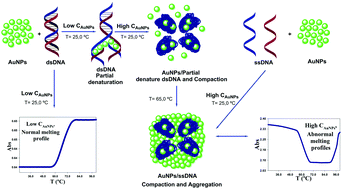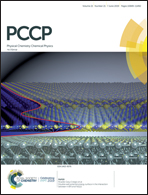What controls the unusual melting profiles of small AuNPs/DNA complexes†
Abstract
The effect of the addition of low concentrations of an inner electrolyte on ds-DNA CT-DNA (calf thymus DNA) and ss-DNA conformational changes induced by small N-(2-mercaptopropionyl)glycine gold nanoparticles (AuNPs) is here studied in detail by using different spectroscopic and structural techniques. The high affinity of ss-DNA to AuNPs compared with ds-DNA is easily demonstrated by the results of competitive binding with SYBR Green I (SG). Additionally, it is proven that at 25.0 °C, AuNPs/ds-DNA and AuNPs/ss-DNA complexes undergo a transition from extended-coil to more compact structures when the AuNPs concentration (CAuNPs) is increased, which for the ds-DNA system is accompanied by partial denaturation. Particularly, for the AuNPs/ss-DNA system all of these techniques confirm that at a high CAuNPs, the compaction process is followed by a discrete transition to aggregation and an increase in structure size. A thorough analysis of the conformational changes described indicates that these processes are larger in low salt concentration and at high temperature. However, the most striking feature of this work is the abnormal melting temperature profiles (Tm) registered at high R = CAuNPs/CDNA ratios, which are remarkable and of interest for chemical sensing. At a suitable R ratio, which varies depending on CNaCl, a complex melting profile for the AuNPs/ds-DNA system was registered with two characteristic transitions: Tm,1 = 65.0 °C and Tm,2 = 95.0 °C. The highly sensitive atomic force microscopy technique performed at 25.0 °C and 65.0 °C also showed a different behaviour in both ss- and AuNPs/ds-DNA systems, which explains the characteristic melting curves. Specifically for the AuNPs/ss-DNA system, AFM at 25.0 °C revealed the formation of large-sized aggregates formed by AuNPs/ss-DNA compact structures linked by AuNPs. However, when both AuNPs/ds-DNA and AuNPs/ss-DNA complexes were incubated at 65.0 °C, the formation of highly stable ordered structures was always visualized at high R. Therefore, this shows that some key parameters for effective control of the formation of DNA/RNA-linked particles are: the selection of an optimal temperature below the ds-DNA melting point, an appropriate CAuNPs, and the addition of low CNaCl. The optimization of these parameters for each AuNPs/DNA system could improve biological sensing and DNA/RNA delivery.



 Please wait while we load your content...
Please wait while we load your content...